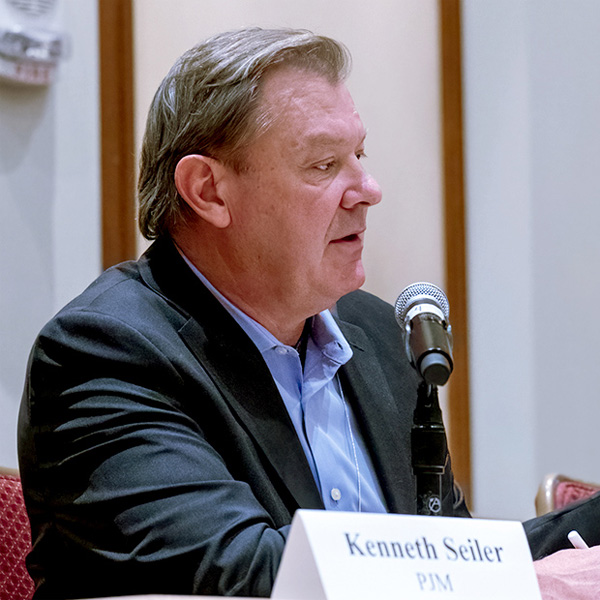Stakeholders Endorse Winter Weekly Reserve Target
VALLEY FORGE, Pa. — The PJM Operating Committee on Nov. 2 endorsed the RTO’s recommended winter weekly reserve target (WWRT) for the upcoming season.
The figure is used to coordinate outages over the winter to mitigate load and forced outage uncertainty. (See “PJM Presents Recommended Winter Weekly Reserve Target Values,” PJM OC Briefs: Oct. 5, 2023.)
PJM’s Patricio Rocha Garrido said the study recommended values of 28% for December, 30% for January and 25% for February. All three months would have higher targets than last year’s study, which had 21% for December, 27% for January and 23% for February.
The higher values are because of changes to the modeling of forced outages over the winter and the inclusion of data from December 2022’s Winter Storm Elliott and the 2014 polar vortex. PJM historically had not included the polar vortex data because of a belief it would not reflect conditions the grid was likely to experience again, but it revised that practice following Elliott.
The WWRT is one of three components of the annual Reserve Requirement Study. The other two, the installed reserve margin and forecast pool requirement, were endorsed by the Markets and Reliability Committee during its Oct. 25 meeting.
PJM Presents Operations Assessment Task Force 2023 Report
PJM’s Thinzar Aung presented the results of the Operations Assessment Task Force’s 2023 winter study, which found the RTO would have a reserve margin of about 17 GW under the conditions normally studied but would be short nearly 5 GW if the specific conditions during the December 2022 winter storm were to occur again.
No reliability issues were found for the base case under the preliminary 50/50 peak load analysis, although some re-dispatching and switching would be required because of local thermal or voltage violations.
A total of 181.1 GW of capacity is expected to be available in the study, with a 90/10 diversified peak load of 141.4 GW.
The single largest gas/electric contingency would reduce available generation by 4.8 GW, the study found. Paired with 16.7 GW of generation outages assumed in the analysis, 5 GW of exports and 7.2 GW of demand response, that leaves a 16.8-GW reserve margin.
The low wind and solar scenario would reduce generation by 4 GW, leaving a 17.6-GW margin.
The Elliott scenario increases the generation outages to 46 GW, reduces demand response to 2.4 GW and assumes a net interchange of 2.8 GW in imports. In such a scenario, PJM would be short 4.8 GW of generation.
PJM’s Chris Pilong said the Elliott scenario was designed to replicate the worst conditions seen during the storm. (See PJM Recounts Emergency Conditions, Actions in Elliott Report.)
“It underscores the need to be prepared and, from a generation perspective, do everything we can to chip away at that 46,000 MW of outages,” he said.
Quick-fix Manual Changes to Transmission Facility Cut-in Process Approved
Stakeholders endorsed a quick-fix proposal to allow PJM to delay energization of a line with a cut-in ticket if the transmission owner has not submitted evidence that all required critical tasks have been completed and the data verified by the RTO. The quick-fix process allows an issue charge and proposed manual changes to be voted on side-by-side.
If the required data have not been received and verified by PJM by 11 a.m. on the day prior to the requested energization date, and extending the outage would not pose reliability concerns, the RTO will delay the in-service date by one day, which can be continued if the data continue to remain unavailable. PJM’s Dean Manno said it takes staff about one day to verify the data.
Manno said critical tasks include submitting parameters such as ratings, impedance, telemetry for tie-lines and monitored priority.
The changes are expected to be brought to the MRC for an endorsement vote Nov. 15.
Generation Winterization Requirements Endorsed
The committee endorsed revisions to Manual 14D: Generator Operational Requirements, which include a requirement for resources to prepare for winter conditions and expanded the winterization checklist.
Part of the manual’s periodic review, the revisions also include several administrative and clarifying changes.
The checklist now prompts generation owners to assess safety hazards posed by snow and ice accumulation on wind and solar facilities, inspect commodities and resources that may be used in severe winter weather, and consider adding a “freeze protection operator” staff member to inspect critical equipment.
PJM’s Vince Stefanowicz said generators can substitute PJM’s checklist for a comparable list of their own.
Clarifying Revisions to Manual 10 Endorsed
The committee endorsed revisions to Manual 10 that would clarify that generators entering outages or their availability into eDART should report their full nameplate capability unless physically derated.
Stefanowicz said physical derates are permanent changes to a resource that reduce its maximum output, such as components being taken offline that reduce output without the expectation of replacing them.

